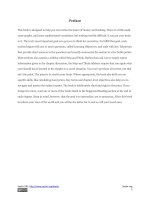Money and Banking: Lecture 20
Bạn đang xem bản rút gọn của tài liệu. Xem và tải ngay bản đầy đủ của tài liệu tại đây (622.06 KB, 32 trang )
Money and
Banking
Lecture 20
Review of the Previous Lecture
• Stocks
• Valuing Stocks
• Dividend Discount Model
• Why Stocks are Risky?
Topics under Discussion
• Stocks
•
•
•
•
Risk and the Value of Stocks
Theory of Efficient Markets
Investing in Stocks for Long Run
Stock Markets’ Role in the Economy
• Financial Intermediation
• Role of Financial Intermediaries
Risk and value of stocks
• The dividend-discount model must be
adjusted to include compensation for
a stock’s risk
Return to Holding Stock for One Year =
Dnext _ year
.
Ptoday
Pnext _ year
Ptoday
Ptoday
Risk and value of stocks
• Since the ultimate future sale price is
unknown the stock is risky,
• The investor will require compensation in
the form of a risk premium
• Required Stock Return (i) =
Risk-free Return (rf) + Risk Premium (rp)
• The risk-free rate can be thought of as the
interest rate on a treasury security with a
maturity of several months
Risk and value of stocks
• Our dividend discount model becomes:
Ptoday
Dtoday
rf
rp g
Risk and value of stocks
• Stock Prices are High when
• Current dividends are high (Dtoday is high)
• Dividends are expected to grow quickly (g is
high)
• The risk-free rate is low (rf is low)
• The risk premium on equity is low (rp is low)
Risk and value of stocks
• The S&P 500 index finished the year 2003 at
just over 1,100. was this level warranted by
fundamentals?
• Risk free real interest rate is about 2% or rf = 0.02
• Risk premium is assumed to be 4% or rp = 0.04
• Dividend growth rate is around 2% or g = 0.02
• The owner of a $1,000 portfolio would have
received $30 in dividends during 2003
Risk and value of stocks
• Substituting the information in our
adjusted dividend discount model:
Ptoday
$30
0.02 0.04 0.02
$
• But the actual stock prices were substantially
higher than this calculated figure
• This may be due to wrong assumption on risk
premium. The investors may have been
demanding lower risk premium in 2003.
• To compute it, we use the same equation
Risk and value of stocks
1,100
$30
(0.02 rp)
0.02
• The answer is approximately 2.75%
The Theory of Efficient Markets
• The basis for the theory of efficient markets is
the notion that the prices of all financial
instruments, including stocks, reflect all available
information
• As a result, markets adjust immediately and
continuously to changes in fundamental values
• When markets are efficient, the prices at which
stocks currently trade reflect all available
information, so that future price movements are
unpredictable.
The Theory of Efficient Markets
• If the theory is correct then no one can
consistently beat the market average; active
portfolio management will not yield a return
that is higher than that of a broad stockmarket index
• If managers claim to exceed the market
average year after year, it may be because
•
•
•
•
They must be taking on risk,
They are lucky,
They have private information (which is illegal), or
Markets are not efficient
Investing in Stocks For the Long Run
• Stocks appear to be risky, and yet many
people hold substantial proportions of their
wealth in the form of stock
• This is due to the difference between the
short term and the long term;
• Investing in stocks is risky only if you hold
them for a short time
• In fact, when held for the long term, stocks
are less risky than bonds.
Investing in Stocks For the Long Run
Investing in Stocks For the Long Run
The Stock Market’s Role in the Economy
• The stock market plays a crucial role in
every modern capitalist economy.
• The prices determined there tell us the
market value of companies, which
determines the allocation of resources.
• Firms with a high stock market value are the
ones investors prize, so they have an easier
time garnering the resources they need to
grow.
• In contrast, firms whose stock value is low
have difficulty financing their operations
The Stock Market’s Role in the Economy
• So long as stock prices accurately reflect
fundamental values, this resource
allocation mechanism works well.
• At times, however, stock prices deviate
significantly from the fundamentals and
prices move in ways that are difficult to
attribute to changes in the real interest
rate, the risk premium, or the growth rate
of future dividends.
The Stock Market’s Role in the Economy
• Shifts in investor psychology may distort
prices; both euphoria and depression are
contagious
• When investors become unjustifiably
exuberant about the market’s future
prospects, prices rise regardless of the
fundamentals, and such mass enthusiasm
creates bubbles
The Stock Market’s Role in the Economy
• Bubbles
• Bubbles are persistent and expanding
gaps between actual stock prices and
those warranted by the fundamentals.
• These bubbles inevitably burst, creating
crashes.
• They affect all of us because they distort
the economic decisions companies and
consumers make
The Stock Market’s Role in the Economy
• If bubbles result in real investment
that is both excessive and inefficiently
distributed, crashes do the opposite;
the shift to excessive pessimism
causes a collapse in investment and
economic growth
• When bubbles grow large enough
and result in crashes the stock market
can destabilize the real economy
Financial Intermediation
• Economic well-being is essentially tied to the
health of the financial intermediaries that make
up the financial system.
• We know that financial intermediaries are the
businesses whose assets and liabilities are
primarily financial instruments.
• Various sorts of banks, brokerage firms, investment
companies, insurance companies, and pension
funds all fall into this category.
• These are the institutions that pool funds from
people and firms who save and lend them to people
and firms who need to borrow
Financial Intermediation
• Financial intermediaries funnel savers'
surplus resources into home mortgages,
business loans, and investments.
• They are involved in both
• direct finance—in which borrowers sell
securities directly to lenders in the financial
markets
• indirect finance—in which a third party stands
between those who provide funds and those
who use them.
Financial Intermediation
• Intermediaries investigate the financial
condition of the individuals and firms who
want financing to figure out which have the
best investment opportunities.
• As providers of indirect finance, banks want to
make loans only to the highest-quality
borrowers.
• When they do their job correctly, financial
intermediaries increase investment and
economic growth at the same time that they
reduce investment risk and economic volatility
Role of Financial Intermediaries
• As a general rule, indirect finance through
financial intermediaries is much more
important than direct finance through the
stock and bond markets
• In virtually every country for which we
have comprehensive data, credit extended
by financial intermediaries is larger as a
percentage of GDP than stocks and bonds
combined









